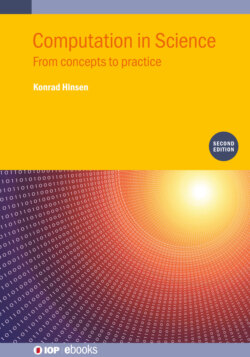Читать книгу Computation in Science (Second Edition) - Konrad Hinsen - Страница 11
1.1.3 Non-numerical computation
ОглавлениеOnce we get rid of the idea that computation is about numbers, we can easily identify other operations that qualify as computations. One example is solving equations by algebraic manipulations. The steps leading from
y+2x=z
to
x=12(z−y)
are completely mechanical and can be formulated as an algorithm. The practical evidence is that computers can do the job. Software packages that implement such operations are called computer algebra systems, emphasizing algebraic manipulations. However, computer algebra systems also perform other non-numerical algorithms, for example finding the derivative or integral of an elementary function. The algorithm for computing derivatives is simple and taught in every calculus course. In contrast, the algorithm for computing indefinite integrals is very complicated [2] and was first implemented as a computer program only in 1987 [3].
A perhaps more surprising use of computation in mathematics is the validation of proofs. A proof is a sequence of deduction steps, each of which establishes the truth of a statement based on other statements already known to be true and a finite set of rules of logic deduction. In textbooks and mathematical publications, proofs are written concisely for human readers who have a prior knowledge of mathematics. But when all the details are spelled out, proofs consist of nothing but applications of a finite set of deduction rules. These rules are applied to statements that must respect the rules of a formal language. The use of computers to check such detailed proofs is becoming more and more common, both in mathematical research and in industrial applications. This involves writing the proof in some formal language, as a sequence of symbols. The ‘proof checking’ computation transforms this sequence of symbols into a ‘true’ or ‘false’ statement about the proof’s validity.
Leaving the narrow scope of mathematics, we find a huge number of domains where computation is applied to textual data. Finding a word in a text is a computation: it transforms the input data (the text and the word to look for) into output data (the position in the text where the word occurs), both of which can be encoded as sequences of symbols. Likewise, aligning two DNA sequences, translating a sentence from English to French, or compiling a Fortran program, are computations in which the data being processed are text. In fact, numbers and text are the two kinds of elementary data from which almost everything else is made up by composition: images are represented as two-dimensional arrays of numbers, dictionaries as sets of word pairs, etc. However, this fundamental role of numbers and text is due to their importance to humans, not computers.
Another kind of data that are becoming increasingly important for scientific computation are graphs, in particular when used to describe networks. Traffic flow, protein interactions in a cell, and molecular structures are all examples of what can be described by graphs. An example of a computation on graphs is a check for cycles. This transforms the input data (a graph) into output data (a list of all cycles in the graph). Encoding graphs, cycles, and lists as sequences of symbols is not as obvious as encoding numbers and text. Humans already represented numbers and text by sequences of symbols long before thinking about computers and computation. The human representation of graphs, on the other hand, takes the form of two-dimensional drawings. The precise techniques for representing graphs as sequences of symbols are beyond the scope of this book, but I will come back to the general question of information representation in computers in section 5.3.2.
